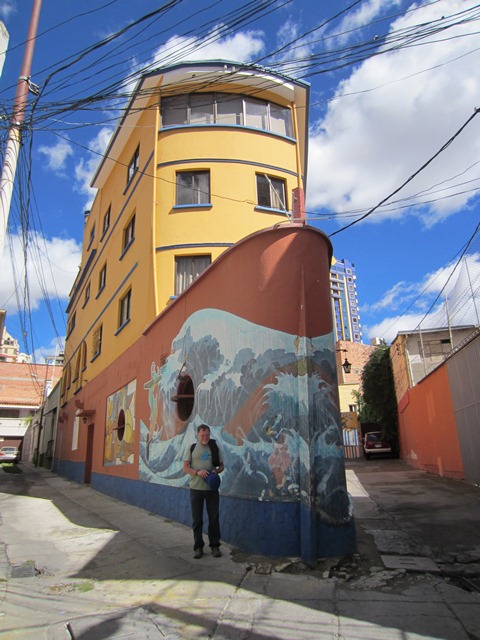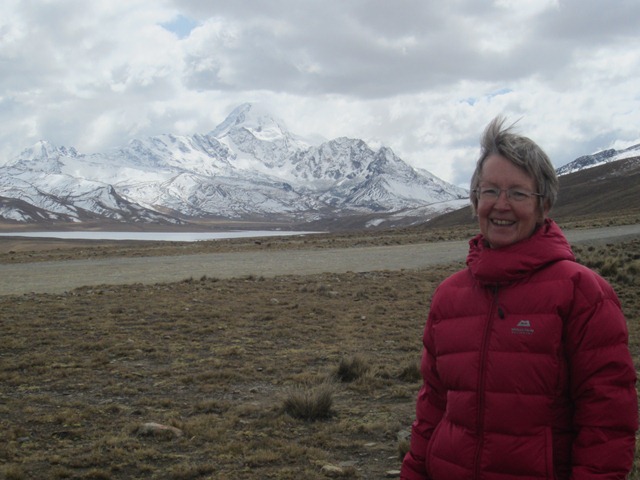The bus trip from Copacabana to La Paz is billed as about 4 hours, but made a bit more interesting by having to cross Lake Titicaca by ferry. Unlike most ferry journeys we’ve taken we passengers are ushered to a ferry boat ticket office whilst our bus (and all our luggage) is loaded onto a barge and manually pushed out onto the lake for quite a way until the motor kicks in. In the meantime we lose sight of the bus as our tiny boat bobs about in the choppy waves.

We’re reunited with the bus after eating some pescaditos (a bit like whitebait) from a street stall, and an uneventful couple of hours later we arrive on the outskirts of La Paz, where the city buildings cling to the sides of steep canyons, an amazing sight. The centre of the city is at an altitude of about 3650 metres, although the difference over the whole city area is about 1000 metres. Later we will find walking up and down the steep streets hard work!

Our budget hostel near the centre of town is comfortable, if a bit chilly. Sorry if this is becoming a bit of a theme, but we are travelling in the winter season here and are still surprised that the hostels and restaurants rarely provide heating. Over the last few days we’ve both been suffering from chesty colds (but luckily not the flu which seems to be dominating the local news) and we decide to bunker down, eat, sleep and not do very much for a few days. To help us relax we find an apartment to rent a few minutes walk from the centre and above a French restaurant. For the first time in months we have somewhere to properly relax and can cater for ourselves. Close by are a couple of supermarkets and a local market for fresh fruit, bread and vegetables, bliss! Oh, and the apartment building is shaped like a ship!

We’re in an area of upmarket residences, embassies and high-rise flats. From our lounge windows and in between the skyscrapers we have a great view of the houses up the steep hillsides.

Walking into town along busy streets there’s the occasional relief from the constant traffic, mostly minibuses and taxis.

On Sundays they close the main street, Prado, to traffic. There’s every kind of stall you can imagine providing food, drink, entertainment, jewellery and the ever essential woollen handicrafts. If you fancy, you can slide down King Kong and get a coffee or icecream at the bottom.

Mostly the streets are full of cars and people. We love wandering around the busy areas, the pavements made more difficult to negotiate by the street vendors. But it’s so interesting, and we see few tourists.

We mooch around, drink coffee and browse the paper in some of the pleasant squares. This is Plaza Murillo, heart of the government metropolis and pigeon central.

Nearby some local women are passing the time of day.

And the main church of San Francisco. Nearby here are many sellers of Saltenas, a cheap local snack of meat in a delicious sweet sauce and covered in pastry, yum ! It’s like a cornish pasty with more sauce inside and very messy to eat, but so delicious we get rather hooked.

After a few days we have regained our energies and decide to venture outside the city. Paul decides to test his mountain biking skills on a trip down the Most Dangerous Road in the World. This involves three or so hours riding downhill on a dirt road to the little town of Coroico. Well, riding is putting it a bit high: it’s a very long dirt track, really, about 40 miles. As long as you don’t get too grabby with the brakes, or lose it on a bend, it’s fine. Make a mistake, though, and it’s a very long drop. Here’s a picture of us giving it some on the way down: I’m the one in front, wearing about ten times more protective gear than I would on a similar ride in the UK.

Diane decides to take a more leisurely option and visits two local areas by bus. First stop is Valle de la Luna, only 10km from the city. It was once mountains of clay, now eroded, leaving a strange area looking a bit like stalagmites protruding from deep canyons.

The highlight of the trip is a visit a couple of hours north into the Cordillera Real in the Bolivian Andes, splendid scenery and a view of Huayna Potosi, a popular outing for climbers at about 6,100m.

Our trusty bus carries on and up to Chacaltaya, once the highest lift-served ski area in the world. Unfortunately skiing has been impossible recently due to lack of snow and rapid glacier melt. However, scientists are monitoring conditions which means that, luckily for tourists, a road is maintained through the snow up to 5,300 metres. From there we plod slowly, huffing and puffing until we reach the top at about 5,400 metres!

We have another couple of days spare, so we mooch around the city and visit a museum or two. We spend a delightful hour in the tiny Museum of Musical Instruments. Paul reminds us how far we’ve come so far on our trip.

Now we are joining a three-week tour to take us further south: all the way to Santiago in Chile. We’re looking forward to someone else organising everything for us for a change!

Really interesting set of pics and descriptions. Diane, I’d really like to see a photo of you dressed in the local costume of blanket and top hat – please!